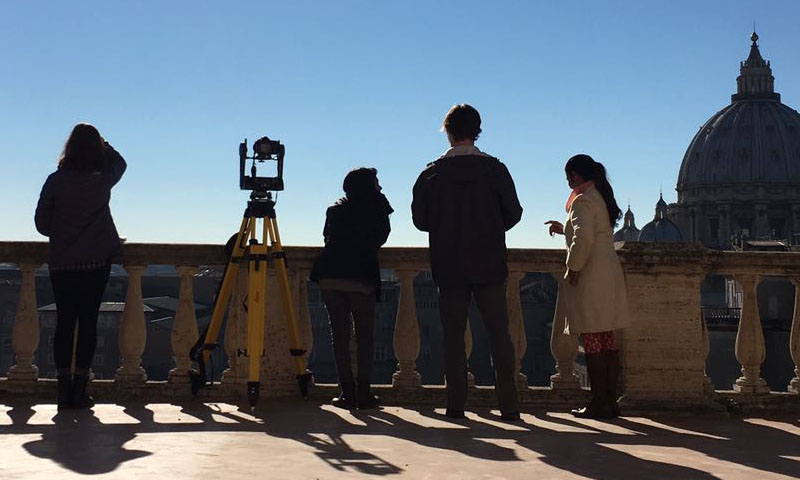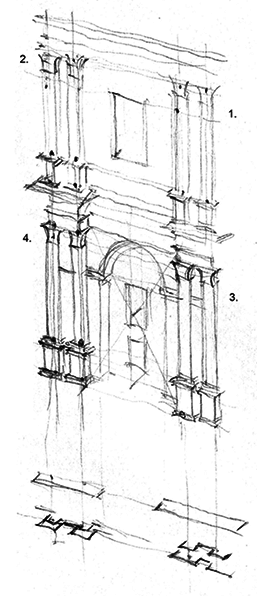|
Rediscovering the Belvedere: Finding architectural significance by drawing |
||||
|
DHARMA's exploration using hand drawings |
The End of Architectural Drawings? Drawing (Lat. trahere – to drag, draw, derive, acquire) is the ability to use the hand to create a form of expression using the tools of illustration, sketch or draft. It requires the ability to observe, create or modify what your mind sees. The sketches of Leonardo da Vinci reveal the inventiveness of his mind. They are hidden stories by themselves that show us what he saw, observed, captured and created. Increasingly, machine-based tools, intended as a medium to replace hand drawing techniques, instead creates new forms of knowledge. While these are all interesting to explore, drawing by hand is slowly becoming a lost skill. The skill of drafting by hand is now completely lost to schools of architecture and is an essential method of informing the mind that cannot be derived through other mediums. The DHARMA (Digital Historical Architectural Research and Material Analysis) Lab, at the School of Architecture, University of Notre Dame, has spent 10 years studying different techniques of data collection on site to document World Heritage Sites. One such project is the Belvedere Cortile in the Vatican City. Here the study focuses on four specific tools used to capture data observed on the site. 1) 3D Scanning – using the state-of-the-art 3D Leica scanner, 2) Gigapan technology –which captures extremely high-resolution photography – a method first invented at Carnegie Mellon, 3) Hand measure drawings (including plans, elevations, details in sketched form), and 4) Field notes on site along with historical references.
Access showcase |
|||
|
This information is brought back to the lab and then processed to create various outputs. Some of the most successful outputs include, 1) Hand drafted drawings and watercolors in 2D (including plans, elevations, details) from the study at various scales, 2) Hand rendered sketches in 3D to explain the evolution of the site, 3) 3D visual apps and large format digital models and 4) Published papers, books and exhibitions. The first, second and fourth outputs employ all data collection techniques to derive the results. The third output of apps doesn’t generally require the results of field notes and hand measure drawing. The Belvedere mapping allowed us to study the site at close proximity and immense precision levels. The results that followed are truly unique and full of amazing insights to the work of the original architects and master builders on the cortile. The findings from the Vatican project has shown us similar findings as those before by the team -- the hand drafted 2D drawings are most useful to the multiple sets of users in deriving new sets of knowledge about the site. These users include, 1) The original creators of the drawing (generally architects and architectural students), 2) The end scientific users like the archeologist, historians, conservators and 3) General visitors to the site. (In the case of the general users, there is awe at the artistic ability of the plates though not a fully informed reasoning).[1]The most important aspect is the general sense of discovery of new information about the site comes through on-site field notes, combined with measured drawings, and 3D knowledge of the site. Thus, the hand drafted drawings are the most informed output created from the study of the site. They are not only artistically pleasing to the eye but are the most revealing from all the formats of outputs used. These, when given to site owners, get used in multiple ways, to make informed decisions about conserving the site while also training the students and architects involved with a sense of new knowledge and skill acquired during the process. These, in the end, become works of art that when placed on acid-free handmade paper can be used for informed understanding of the site as well as artistic expressions to be archived for posterity as renowned artists and architects once did. |
||||
 Featured Discussions Featured Discussions  |
||||
|
[Image in work] |
Uses of Perspectives in Bramante's Design Dr. Krupali Krusche "The ongoing study, started in 2015, by the DHARMA (Digital Historic Architectural Research and Material Analysis) Labon digitally documenting the Belvedere shows new insights regarding the way the Cortile was designed originally by Bramante. This paper will bring forward these new findings in the field of design and execution of the complex on-site. It presents observational and analytical studies from the scan data and line drawings produced from the upper courtyard of the Belvedere. These bring better insights into understanding how each bay along the loggia of the cortile was manipulated to create a perspectival view throughout this vast complex. The use of stairs and other architectural elements to enhance the perspectival sense of the space, not visible at the first look, will also be presented. The most important aspect is the general sense of discovery of new information about the site through on-site field notes, combined with measured drawings, and 3D knowledge of the site."
|
|||
|
[Image in work] |
Understanding the Design behind Drawings Dr. Krupali Krusche "Italian Renaissance painters and architects including Masaccio, Paolo Uccello, Piero della Francesca and Luca Pacioli studied linear perspective, wrote treatises on it, and incorporated it into their artworks, thus contributing to the mathematics of art. The first to master perspective was Italian Renaissance architect Filippo Brunelleschi, who developed the adherence of perspective to a vanishing point in the early fifteenth century. His discovery was immediately influential on subsequent Renaissance art and was explored contemporaneously in manuscripts by Leon Battista Alberti, Piero della Francesca and others. At the Vatican, for the Belvedere project, the research didn’t start with the drawing process but with collecting information related to all drawings ever done about it. These included 1) Paintings, 2) Free hand sketches, 3) Architectural drawings (including plans and elevations), 4) Perspectives, 5) Axonometric drawings and last but not least, 6) Hypothetical reconstructions. Also with drawings a sense of written history was documented to accumulate a chronological study of the transformation of the Belvedere from 1503 till today. Though not all exhaustive, this was a good start for getting a sense of the breadth and depth of knowledge needed to tackle the making of the drawings of the belvedere. After collecting this information, attention was placed on creating pre-site drawings." |
|||

